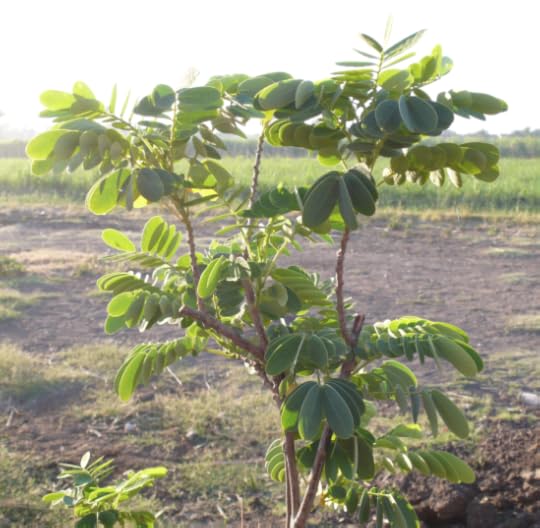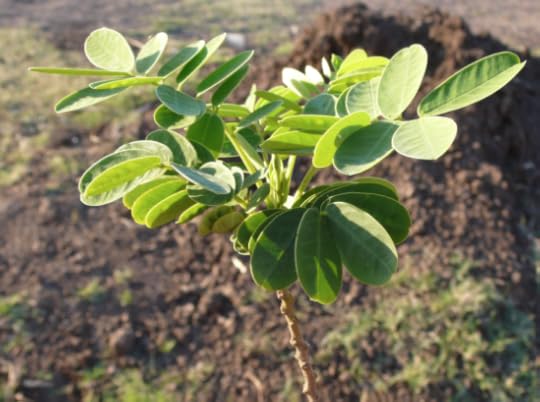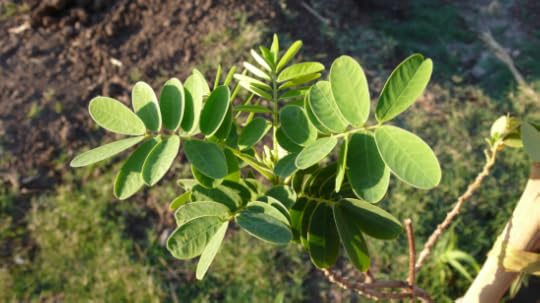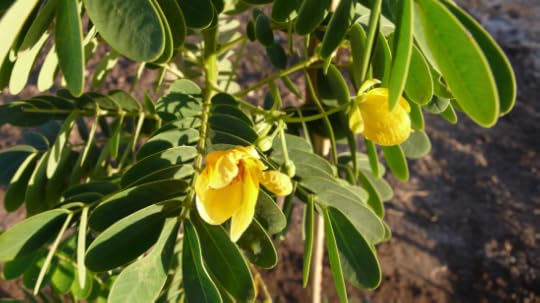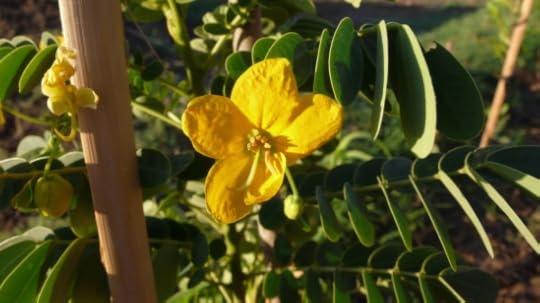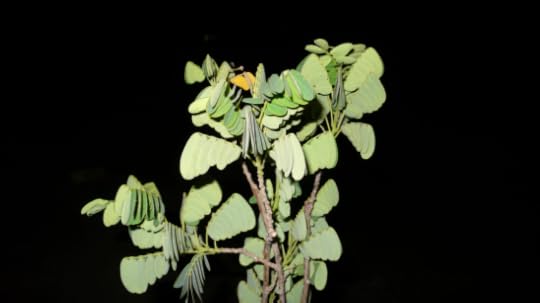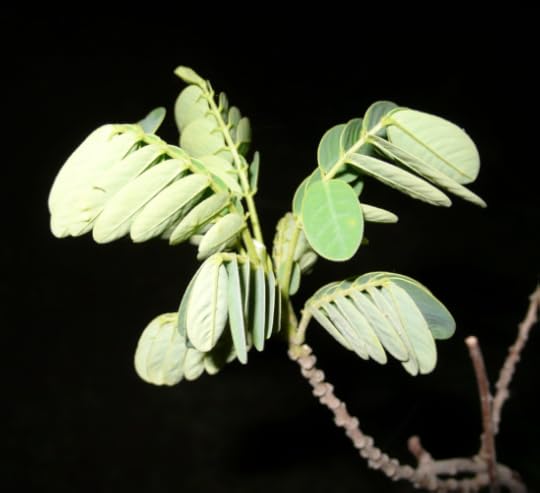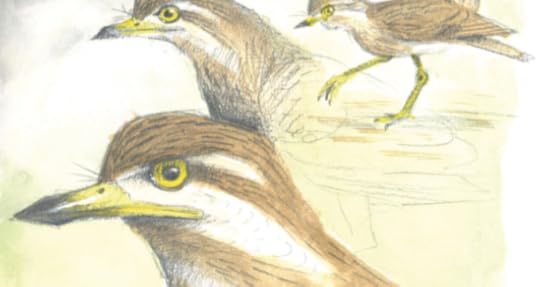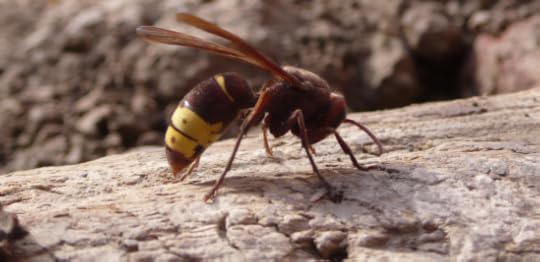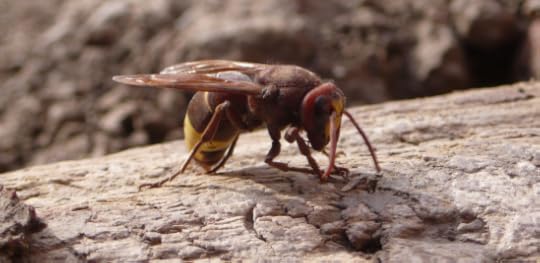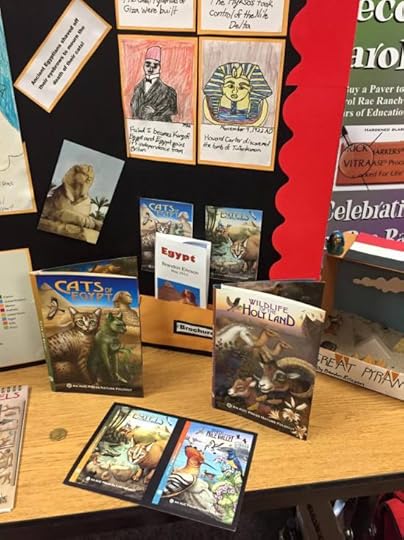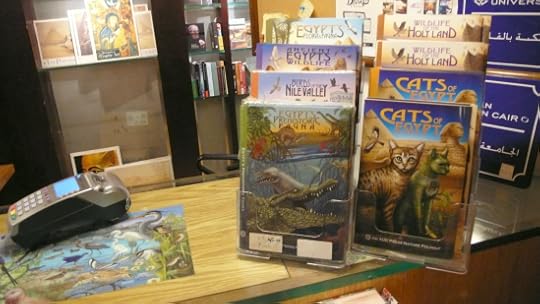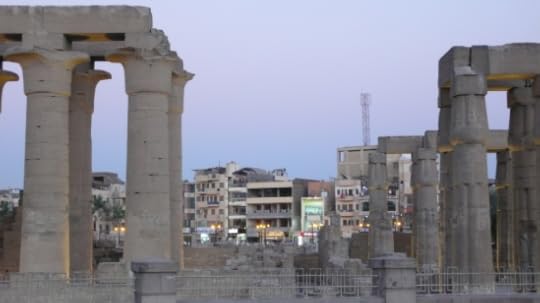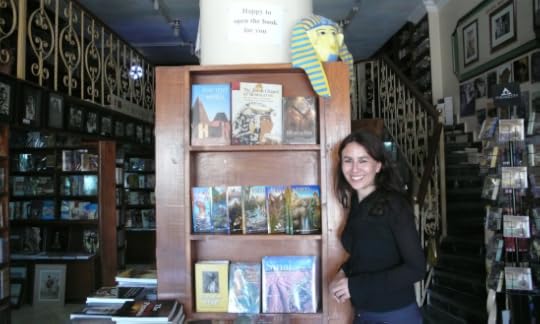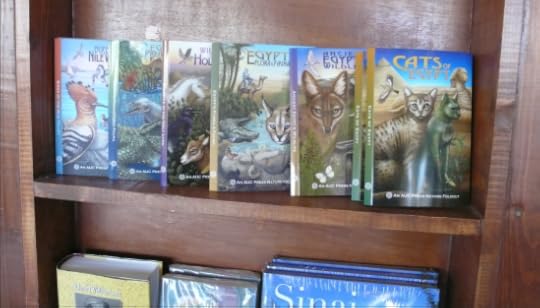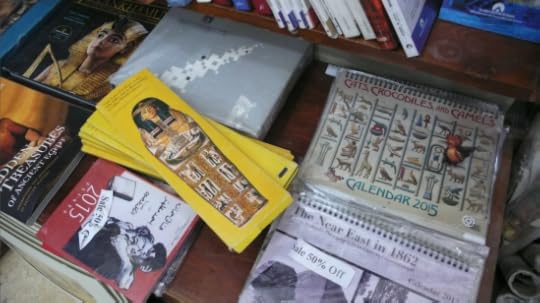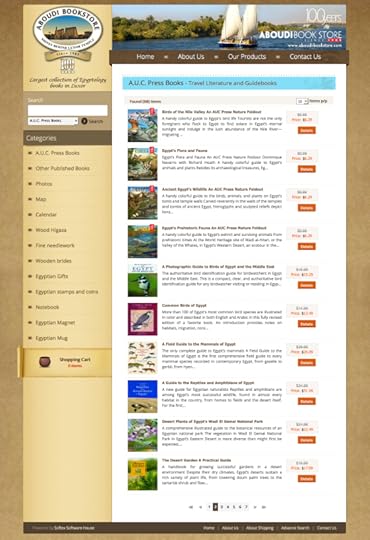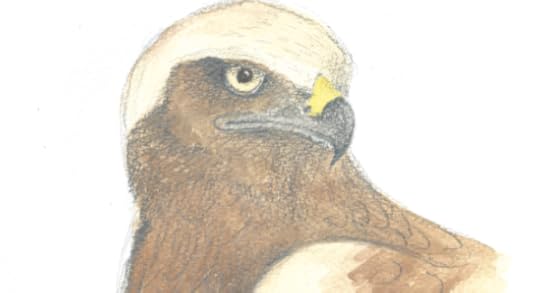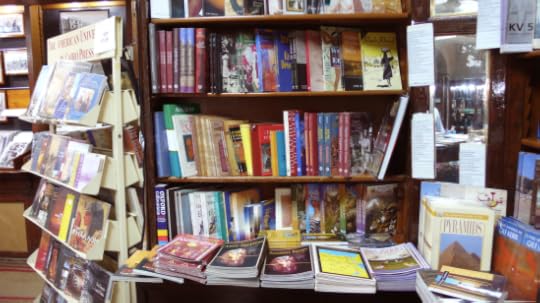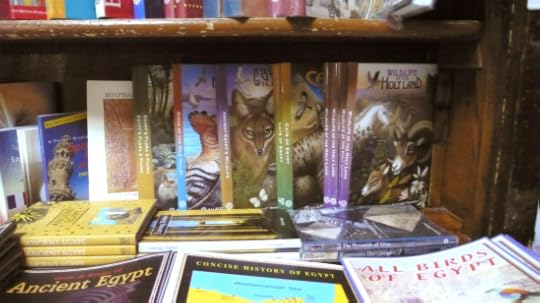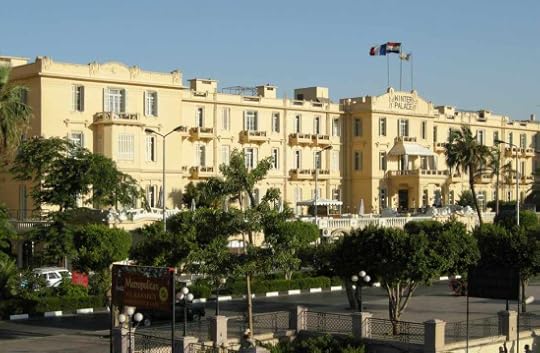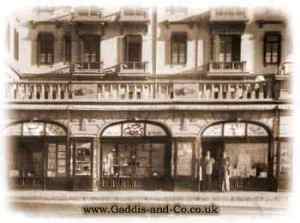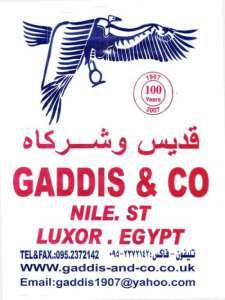Dominique Navarro's Blog, page 11
June 8, 2015
Cassia surattensis, a common tree of Egypt
The Cassia surattensis is a lovely, small evergreen tree found throughout Cairo and Giza, and along the streets of Luxor in Upper Egypt, where it flowers almost throughout the year. (These are photos of a young tree, recently planted.)
It can grow 2-4 meters high and has pinnate-divided compound leave, elliptical leaflets, 10-18 cm long pods, and bright yellow flowers which attract butterflies.
It is described in the book The Street Trees of Egypt as a tree which has only recently been cultivated in Egypt, and is native to tropical Asia, Australia, and Polynesia. It was commonly found in folk medicine to treat various diseases. The bark and leaves have been used to treat fungal skin diseases, and its roots were a cure for snake bites in India, while in Malaysia, the boiled leaves are consumed to relieve cough and sore throat. (According to the Research Journal of Pharmaceutical, Biological and Chemical Sciences)
In the book, The Power of Movement in Plants (1915), Charles Darwin described the Cassia plant for its ability to “sleep” at night: with the sunset, the leaves relax and fold downward, and reopen again in the morning.
The Street Trees of Egypt, by M. Nabil el-Hadidi and Loutfy Boulos, and illustrated by Magdy el-Gohary and Sami Makar (American University in Cairo Press, 1988).
Filed under: Related Stories, Ventures & Vistas in Egypt








June 6, 2015
Richard Hoath’s Article in Egypt Today, “Cairo Chorus”
Richard Hoath, a scientific consultant for the AUC Press Nature Foldouts, has a new article in Egypt Today, about the birds of Cairo.
http://egypttoday.com/blog/2015/05/18/cairo-chorus/
How unique is Cairo’s dawn chorus? Awake before the fajr, the dawn prayer, perhaps in anticipation of a potential ornithological extravaganza to come, the pre-dawn darkness was cleft apart by the hysterical shrieking of the karawaan, the Senegal Thick-knee.
What followed as dawn did begin to break was rather more prosaic. It was the House Sparrows first, the ubiquitous small brown bird, the male of which is subtly resplendent, well less than dowdy, in gray cap, black bib and streaked upperparts. House Sparrows at dawn do not sing, they just cheep but they cheep in their thousands in Cairo and it is the wall of sound against which the soloists perform. The earliest of these is perhaps the Laughing Dove, also known as the Palm Dove.
The karawan pretty well nailed it instantly but the mélange of sparrow and bulbul and of swifts and warblers, falcons and doves all give the city a unique wake-up call. You can even narrow down the district. Tremulous mews would mean Black Kites and probably Maadi. Harsh — very harsh — squawks would mean Rose-ringed Parakeets and either Zamalek or Heliopolis but expanding elsewhere. And friends from Zamalek who are daily victims of their early morning squawks really wish they were elsewhere.
Filed under: Egypt News - Environment & Egyptology








June 5, 2015
Egypt’s Oriental Hornet, Vespa orientalis
During my recent trip to Egypt, I had a rather close encounter with a large hornet which I’ve now identified as an Oriental Hornet, Vespa orientalis.
Brushing my hair one morning, I happened to glance in the mirror only to see a hornet sitting quite calmly on my neck. My reaction was shock, and fear of the sting I was about to endure. I knew better then to swat it off with my hand, not wanting to provoke it. The next minute or two I simply tried to prepare for pain, wincing with the thought of it, but it never came. Looking in the mirror again, it was gone, and I couldn’t find it anywhere. It was as though it had never been. Being in Egypt, I thought this must be some sort of divine sign of something… in any case, I was quite relieved.
I continued to see these hornets nearly everyday and feel confident that it is Vespa orientalis. The Oriental Hornet has a broad range from Central Asia and southern Europe, to North Africa and the Middle East. It is the only member of the Vespa genus of hornets that can be found in desert climates.
They appear very large, measuring up to 35 mm long. They are a reddish brown color, with a large yellow band across their abdomen. Uniquely, the Oriental hornet can “harvest” solar energy utilizing a structure in its abdomen that traps sun rays, and a special pigment that harvests the energy captured. This allows them to be more active in the heat of mid-day. A fascinating article by BBC Earth News can be read here: http://news.bbc.co.uk/earth/hi/earth_news/newsid_9254000/9254445.stm
Their diet consists of fruits and nectar, but also includes other insects, including honey bees, flies, and grasshoppers which they feed to the colony’s brood, the queen’s offspring. They cause serious damage to honey bee colonies and are their major predator. Because they are scavengers, they also can transmit diseases to bee hives, plants, and crops.
The Oriental Hornets sting is painful and their stingers can be used multiple times. They also have strong jaws and can bite if provoked!
Grateful my close encounter had neither bite nor sting!
Filed under: Related Stories, Ventures & Vistas in Egypt








Egypt’s Oriental hornet, Vespa orientalis
During my recent trip to Egypt, I had a rather close encounter with a large hornet which I’ve now identified as an Oriental hornet, Vespa orientalis.
Brushing my hair one morning, I happened to glance in the mirror only to see a hornet sitting quite calmly on my neck. My reaction was shock, and fear of the sting I was about to endure. I knew better then to swat it off with my hand, not wanting to provoke it. The next minute or two I simply tried to prepare for pain, wincing with the thought of it, but it never came. Looking in the mirror again, it was gone, and I couldn’t find it anywhere. It was as though it had never been. Being in Egypt, I thought this must be some sort of divine sign of something… in any case, I was quite relieved.
I continued to see these hornets nearly everyday and feel confident that it is Vespa orientalis. The Oriental hornet has a broad range from Central Asia and southern Europe, to North Africa and the Middle East. It is the only member of the Vespa genus of hornets that can be found in desert climates.
They appear very large, measuring up to 35 mm long. They are a reddish brown color, with a large yellow band across their abdomen. Uniquely, the Oriental hornet can “harvest” solar energy utilizing a structure in its abdomen that traps sun rays, and a special pigment that harvests the energy captured. This allows them to be more active in the heat of mid-day. A fascinating article by BBC Earth News can be read here: http://news.bbc.co.uk/earth/hi/earth_news/newsid_9254000/9254445.stm
Their diet consists of fruits and nectar, but also includes other insects, including honey bees, flies, and grasshoppers which they feed to the colony’s brood, the queen’s offspring. They cause serious damage to honey bee colonies and are their major predator. Because they are scavengers, they also can transmit diseases to bee hives, plants, and crops.
The Oriental hornets sting is “painful” and their stingers can be used multiple times. They also have strong jaws and can bite if provoked!
Grateful my close encounter had neither bite nor sting!
Filed under: Related Stories, Ventures & Vistas in Egypt








May 23, 2015
Nature and Art Adventures with Zeenab
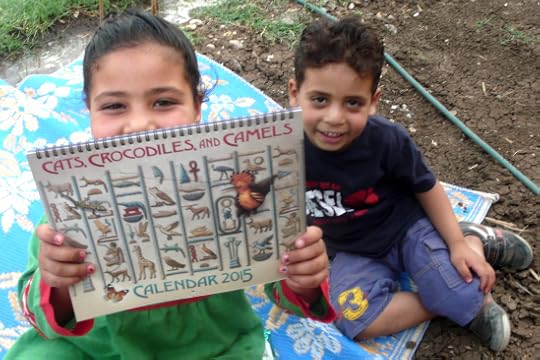
Who loves Egypt’s AUC Press Nature Foldouts? Well, we hope Zeenab and her brother Hussain do!
Zeenab loves camels!
And she likes planting trees too!
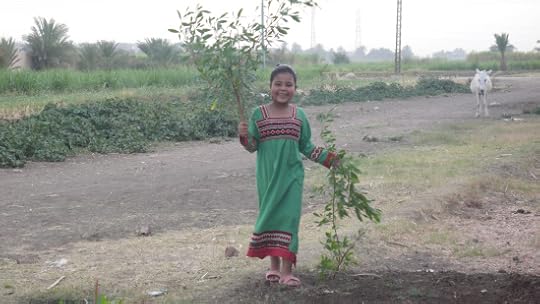
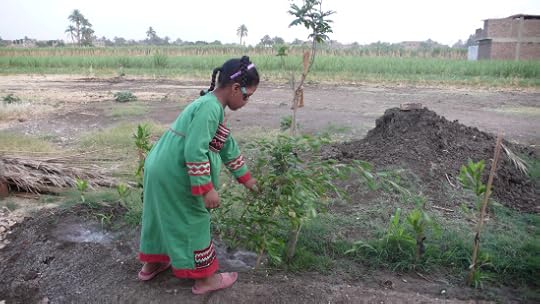
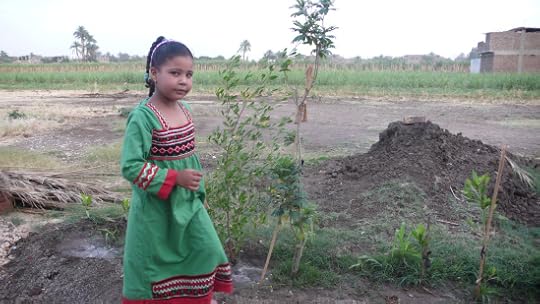
And she likes to draw! I call her drawing KID-Glyphs!
We hope that the AUC Press Nature Foldouts will soon be available in an Arabic version, for kids like Zeenab and her brother to enjoy!
Filed under: Related Stories








May 14, 2015
Brandon’s Egypt Presentation, with AUC Press Nature Foldouts!
 One of my favorite kids, Brandon, giving a school presentation on Egypt, with help from the AUC Press Nature Foldouts!
One of my favorite kids, Brandon, giving a school presentation on Egypt, with help from the AUC Press Nature Foldouts!
Filed under: AUC Press Nature Foldout News Updates








May 13, 2015
Meeting in Cairo at AUC Press!
Had a successful meeting in Cairo with AUC Press at their offices next to Tahrir Square, where a new pole was raised with the nation’s flag in February, hoping to unify Egyptians. During my last visit in 2013, a memorial dedicated to protesters killed by security forces was torn down by the people in just a matter of days. Today, things seems much calmer, quieter, while signs of the turmoil still remain: a few road blockades still in place, barbed wire, political graffiti, and a military/police presence everywhere.
Inside the American University of Cairo old campus bookstore, all of the AUC Press Nature Foldouts are available, right at the cash register. Come visit!
P.S. Exciting new publications are soon to come!
Filed under: AUC Press Nature Foldout News Updates








Aboudi Bookstore in Luxor – AUC Press Nature Foldouts Available
AUC Press Nature Foldouts are available at Aboudi Bookstore, across from Luxor Temple.
It has a wonderful selection of books including many publications by AUC Press. Drop by their store on El Karnak Street!
All 6 AUC Press Nature Foldouts are currently located at the front of the shop, just as you walk in! Thanks so much Aboudi!
The 2015 Calendar—Cats, Crocodiles and Camels, featuring the artwork by Dominique Navarro for the AUC Press Nature Foldout series—is also still available at 50% off.
Aboudi Bookstore also has a website providing a list of their fantastic selection of books, artwork, photos, and a variety of gifts, ordering and shipping options, and a lovely history of their store celebrating over a 100 years of service! http://www.aboudi-bookstore.com
You will also find the AUC Press Nature Foldouts available on their website: http://www.aboudi-bookstore.com/onlinestore/search.php?category=466&subcategory=556
Filed under: AUC Press Nature Foldout News Updates








Richard Hoath’s Article in Egypt Today, “Birds of Spring”
Richard Hoath, a scientific consultant for the AUC Press Nature Foldouts, has a new article in Egypt Today, about the birds of spring.
http://egypttoday.com/blog/2015/04/21/birds-of-spring/
Harriers, herons, swamphens and more birds can all be seen at this time of year — and you won’t even have to leave the city to find some of them
Filed under: Egypt News - Environment & Egyptology








May 12, 2015
Gaddis & Co. Bookstore in Luxor – AUC Press Nature Foldouts Available
AUC Press Nature Foldouts available at Gaddis & Co. Gift and Bookstore, in front of the legendary Winter Palace.
Open since 1907, it has a wonderful selection of books including many publications by AUC Press.
Photos of the store from 1907 and again in 2007!
Drop by their store on Corniche Al Nil!
Filed under: AUC Press Nature Foldout News Updates









